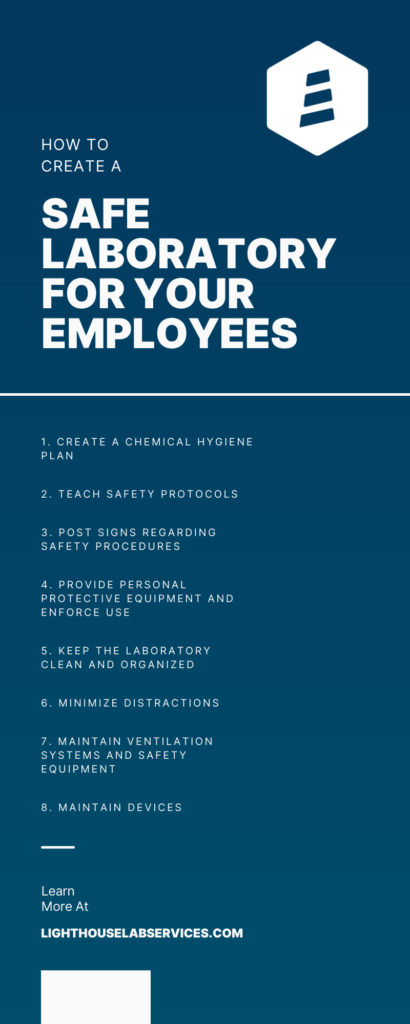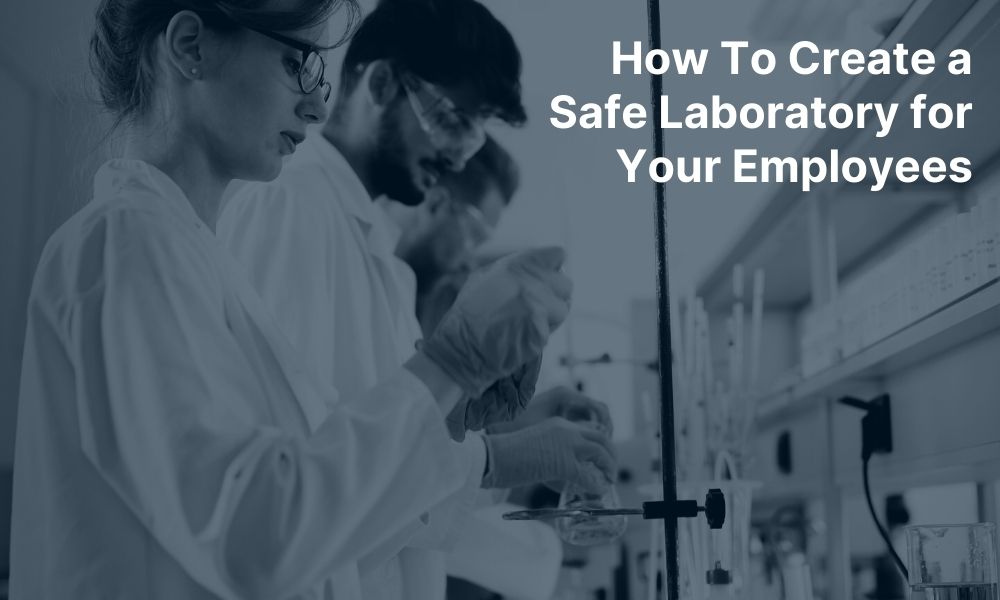In a laboratory, workplace safety is a paramount concern. Laboratory equipment, supplies, and waste present many chances for items to get damaged and people to get hurt. But accidents and unwanted outcomes can be avoided in a laboratory that fosters a safe work culture.
Develop and execute safety standards and practices that protect everyone. Learn how to create a safe laboratory for your employees.
 1. Create a Chemical Hygiene Plan
1. Create a Chemical Hygiene Plan
Your laboratory should have a chemical hygiene officer—an employee with qualified training or experience—to create a chemical hygiene plan (CHP). The CHP is a document detailing the procedures, equipment, personal protective equipment, and work procedures that keep employees safe around hazardous chemicals. The CHP must adhere to standards in the OSHA document “Occupational exposure to hazardous chemicals in laboratories,” standard number 1910.1450.
The employer must review the CHP annually and update it as needed. The plan should be available to employees and employee representatives, and employees should be trained on the details of the plan. The CHP informs employees of their rights and duties regarding the use of hazardous chemicals in the lab.
2. Teach Safety Protocols
A well-crafted CHP details your organization’s health and safety practices, which is a key part of how to create a safe laboratory for your employees. Next, it’s important to clearly communicate safety procedures to all lab workers. Everyone needs to understand how to properly work with equipment and supplies, how to use protective equipment, and what to do if something goes wrong.
Periodically reteach these lessons. Regularly scheduled safety trainings keep all employees up to date on best practices for limiting occupational risks. You can teach safety procedures in meetings, through printed materials, or by offering online safety courses.
3. Post Signs Regarding Safety Procedures
Lab staff work with hazardous chemicals, biological specimens, sharp devices, and many other potentially dangerous objects. Posting signs around the laboratory provides a constant reminder of workplace standards. These signs clearly indicate hazards and guide employees on their best course of action.
Your signs can include information about the hazards of specific chemicals. You can also have signs regarding general safety rules, such as “no eating or drinking in the lab.” And it’s a good idea to post useful phone numbers near exits in case of an emergency. Signs can also relay information about physical hazards, such as magnetic fields.
Everyone should be aware of the meanings of standard laboratory safety signs, the Hazard Communication Standard (HCS) pictographic signs created by OSHA. These signs include symbols framed by a red diamond border. The images warn about hazards such as flames, corrosion, gases under pressure, and other conditions a worker might encounter in the laboratory.
4. Provide Personal Protective Equipment and Enforce Use
You must provide personal protective equipment (PPE) to people in the lab. PPE protects people’s bodies, eyes, faces, hands, hearing, and respiratory functions.
Visitors should wear protective eyewear and lab coats. Give your employees protective gear including gloves, protective eyewear, and lab coats in the right size. Depending on the chemicals that employees work with or the tasks they need to complete, you might need to provide additional PPE.
Employees must know how to properly wear the equipment, adjust it, maintain it, and discard it. And they must understand the functions and limitations of the PPE. You must enforce that your staff wears the appropriate PPE as they work. Employees should also come to work dressed appropriately, with long pants and closed-toe shoes.
5. Keep the Laboratory Clean and Organized
The cleanliness and organization of the lab influences the safety level for employees. Clutter can lead to accidents, like contamination or spills. And everyone will have an easier time identifying potential hazards in an organized lab.
Walkways and surfaces can easily be cluttered by bags, jackets, and other personal items. Employees should keep personal items in a storage area outside of the lab.
Make sure to label all chemicals clearly and store them properly according to temperature, humidity, and light sensitivities. Employees should know where to locate safety equipment and supplies as well. And laboratory devices should be logically positioned to allow for enough clear workspace.
To keep the laboratory clean, establish a cleaning schedule. Employees should clean surfaces regularly, and spills should be cleaned immediately. Different situations and materials require different cleaning methods, so clean at the appropriate level.
6. Minimize Distractions
Creating a work environment that fosters focus and cooperation will help keep everyone safe. Food is a possible distraction that also poses the threat of increasing experimental contamination. Eating and drinking also increases employees’ risk of exposure. Don’t allow eating or drinking in the lab.
Employees must stay aware of their task, the environment, and what other people are doing around them. Any activity that takes away these abilities threatens employee safety.
For example, headphones prevent employees from hearing their surroundings. If an employee listens to music on the job, it decreases their level of awareness. Always enforce attention in the workplace.
7. Maintain Ventilation Systems and Safety Equipment
It’s also important to protect employees from airborne problems. Maintain ventilation, air filtration systems, and chemical fume hoods to reduce the risk of exposure.
Make sure that all safety equipment stays in working order. All eyewash stations, safety showers, and fire extinguishers should function as intended. Periodically check these items to ensure compliance. Cleaning is also an important part of maintenance. For example, if a handwashing station becomes clogged, you must unclog it immediately to avoid backup and contamination.
8. Maintain Devices
You’ve equipped your laboratory with the best devices for you to analyze and store samples. Having the appropriate devices goes a long way in keeping the laboratory up to speed in terms of both throughput and safety.
You must maintain your equipment to ensure it continues to work efficiently, correctly, and safely. In addition to regular cleaning, follow the manufacturer’s instructions for maintenance and use.
If a lab member notices that equipment is damaged or supplies aren’t stored correctly, they should notify their supervisor immediately. Damaged machinery should be pulled from service and either repaired or replaced. Damaged supplies should be discarded appropriately.
Use Lighthouse Lab Services
Lighthouse Lab Services is the nation’s leading laboratory consulting firm. We have managed over 200 laboratories across the country. Reach out to us for lab management services to create a compliant and safe workspace for your employees.
Contact us today for a free consultation.
